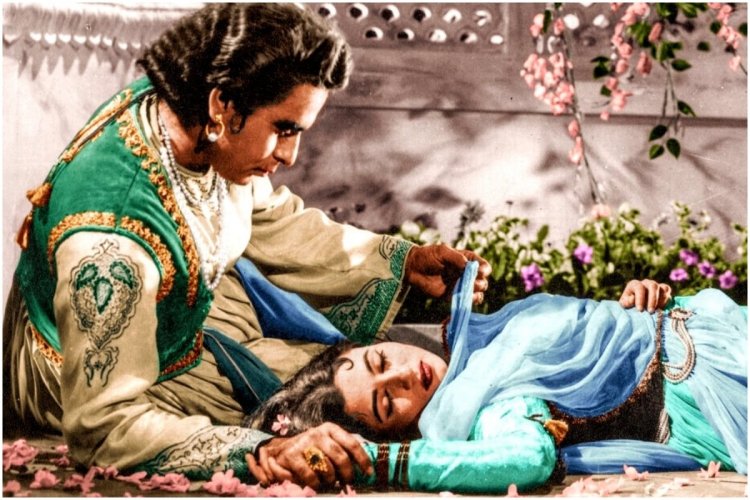Mughal-e-Azam: The Legacy That Follows

If there is to be named an Indian film living and thriving to this day (Literally!), it has to be Mughal-e-Azam.
Although Mughal-e-Azam revolves around the love story of Salim and Anarkali, it maintains its focus on Emperor Akbar. The film’s screenplay is based on the play called Anarkali written by Imtiaz Ali ‘Taj’, in 1922 and rewritten in 1931.
The intriguing story takes place in Lahore and is woven around the growing love between a servant girl and the crown prince. The offended emperor puts an end to this love story by ordering Anarkali to be buried alive in four walls (of a dungeon). This end scene was, however, changed in the film as the reviews from the preview.
Directed by K. Asif, the 1960 film 'Mughal-e-Assam' starring Prithviraj Kapoor, Dilip Kumar and Madhubala was a huge hit across India. Lata Mangeshkar sang 12 songs to the music of Naushad. To this day, the duo of Saleem and Anarkali remains a symbol of eternal undying love.
The black and white film 'Mughal-e-Assam' was last colour-changed in 2004 and the sound-light was digitized and re-released.
At the present day, K Asif's classic 'Mughal-e-Azam' marked 60 years ago of the movie. To mark this momentous day, the film's screenplay has been inducted in the Oscars library. Director K Asif’s son Akbar Asif presented the screenplay of the film to the Oscars library in Hollywood.
"The journey of Mughal-e-Azam started with words from the greatest writing team ever assembled in Hindi cinema and I thought the best way to honour them was to permanently preserve their screenplay in the world’s most renowned film library," said Akbar Asif, a businessman based in London.
"I hope future generations can learn and get inspired by the work of my late father and his incredible team of writers. I want to humbly thank the Academy Awards for accepting the screenplay," he said.
The Vision
K. Asif’s vision was to bring to the screen all the majesty and grandeur of the Mughal courts and as such he wanted to make the costumes and jewellery to be as authentic as possible. The costumes in Mughal-E-Azam were directly inspired by the kinds of clothes worn in the Mughal era.
From the iconic costumes of Anarkali down to Prince Salim’s slippers, every aspect of the costume design was carefully selected and created to imitate the historical costumes of the period the film was set in. That being said, there were a few modern innovations that were incorporated as a part of necessary cinematic liberties required to create a majestic look on screen.
The Making of the Film
One of greatest contributors to the grand scale of Mughal-E-Azam was the costumes design. A lot of money was spent to ensure that the costumes looked as grand and authentic as possible. Tailors from Delhi, skilled in the art of zardozi embroidery, were brought down to Mumbai to stitch the various Mughal costumes.
Specialists from Surat embroidered the costumes with intricate zari and zardozi designs. This kind of attention to detail also extended to other aspects of the costume. Hyderabadi goldsmiths designed the period jewellery while authentic footwear was specially ordered from Agra. Even the crowns worn by the actors were exclusively designed by craftsmen from Kolhapur.
The screenplay of the film, which hit the screens in India on August 5, 1960, was crafted by a team comprising Aman, Kamal Amrohi, Wajahat Mirza, Ehsan Rizvi as well as director K Asif.
At the time of its release in 1960, the film had an all-India release in 150 theatres simultaneously. A digitally-colourised version of the epic re-released in theatres in 2004, bringing out the beautiful colours of the places it was shot in, especially the classic song of a rebel in love, Pyaar Kiya Toh Darna Kya, and the shots of Sheesh Mahal.
Mughal-e-Azam: The Musical
In 2016, an official live musical based on this film made history as one of the biggest theatre productions ever staged anywhere in the world.
When film and theatre director Feroz Abbas Khan was scouting for venues in Delhi, he drew a blank. There was just nothing that could host a stage play of such unprecedented scale and complexity. When Khan finally settled on JLN, he had to refurbish it to the extent that it is literally a new place now: cleaning up, painting the walls, carpeting the floor, the works. “But everyone has been so helpful, they have been magnificent. However, our costs are colossal,” he says, waving at the smooth new walls as he gives me a guided tour of the premises. “I joked with my partners that it would be cheaper to charter three planeloads of people from Delhi to Mumbai, give them rooms in a five-star hotel and get them to see the play. Even if we have full houses here for every show, we will run at a huge loss.”
When Khan decided to take Mughal-e-Azam to the stage he first approached Mumbai’s National Centre for the Performing Arts (NCPA), known for its state-of-the-art facilities that allow complex productions to be staged. NCPA chairman Khushroo Suntook immediately came on board as a partner.
Next, Khan went to Shapoorji Pallonji, the business conglomerate that had produced the film in 1960, to get the stage rights. Deepesh Salgia, director at Shapoorji Pallonji, who has been handling the brand as a passion project for 20 years, not only agreed but came on as a co-producer, because, as he says, “If we were going to do a play, it had to be grand, it had to be something never seen before on the Indian stage, it had to keep up the parampara of the film.”
And that’s exactly how Mughal-e-Azam the stage musical turned out: with its cast and crew of over 350 people, with more than 200 lights illuminating the stage, 550 costumes designed by Manish Malhotra, not to mention the live singing on stage (original songs from the film, including the show-stopper Pyar kiya toh darna kya) along with dazzling Kathak sequences performed by 30 classically trained dancers.
The play has already had 57 housefull shows in Mumbai. Despite the cost and the challenges of finding a suitable venue in Delhi, the director and producers felt it had to be staged here. “How can you not show a play like Mughal-e-Azam in Delhi with its great Mughal history?” asks Khan.
For the last several years Khan has been associated with minimal, successful plays such as Tumhari Amrita (which has now run for over 20 years). “But I thought if I keep making minimal productions, my style will become my own cliché,” says Khan. “As I became more and more successful, I realised it was time to go on a path where there was a serious possibility of monumental failure.”
That failure loomed large three days before October 21 last year, the opening night of Mughal-e-Azam in NCPA. “I was emotionally exhausted,” recalls Khan. “I thought everything was going wrong. I felt I needed 15 more days for the production to settle itself because it had become technically so complicated. But we were committed to opening on that day.” So Khan says he “did a few things” and magically it all fell into place. The show opened to a rapturous response. “Honestly, I felt more relieved than anything else,” says Khan. He finally said:
“I was just happy I hadn’t let down Shapoorji Pallonji and K Asif.”
Three versions of the legendary screenplay- in Hindi, Roman text and English translation, are now available at the Margaret Herrick Library, a world-renowned reference and research collection of the Academy devoted to the history and development of the motion picture as an art form and an industry.
Mughal-e-Azam went on to break every box office record and is still considered one of the highest-grossing Bollywood films of all time.















































